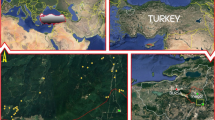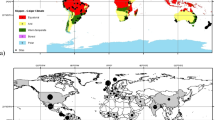Abstract
Quantitative field measurements of biological nitrogen fixation (BNF) and biomass production by four different understorey pastures in a Pinus radiata-pasture agroforestry system were determined over a period of one year. The trees were two years old at the beginning of this study and the understorey pastures were being cut and removed for silage. The BNF was determined using the 15N dilution technique. Pastures of ryegrass+clover, cocksfoot+clover, phalaris+clover and lucerne were used. Substantial amounts of BNF were found (71 to 230 kg N ha−1 year−1) with lucerne showing the highest N fixation. However, lucerne derived only 71 to 72% of its N from the atmosphere (%Ndfa) during the spring/summer period compared to 83–97% with clovers, thus the net N demand from the soil was substantially higher with lucerne. This caused increased N stress to the trees. Clover in ryegrass+clover pasture fixed more N than the other grass+clover pastures. Although pasture position in relation to trees did not affect annual pasture total DMY and %Ndfa, pastures north of tree row grew better than those in other positions. Trees significantly affected the BNF of legumes and the botanical composition of pastures with highest BNF and legume production occurring in pastures midway between two rows of trees. These results suggest that it would be advantageous to evaluate different legumes and grasses for tolerance of shade and moisture stress in future studies. As the trees studied were only 1.5 to 3 m in height, their effects on BNF, seasonal pasture biomass production and botanical composition are expected to increase with tree dominance in the ecosystem with time. Amounts of N fixed were related to the productivity (i.e. dry matter and N yield) and seasonal persistence of the legumes. The productivity was high in spring and summer and low in autumn and winter.
Similar content being viewed by others
References
Avery ME (1991) Nitrogen fixing plant interactions in agroforestry. In: Avery ME, Cannell MGR and Ong CK (eds) Biophysical Research for Asian Agroforestry, pp 125–141, Winrock Intern, USA
Baars JA, Douglas JA, Knight T and Janson CG (1990) Growth rates and relationships between weather and growth rates for lucerne (Medicago sativa L.) in Canterbury and Rotorua-Taupo region. Proc NZ Grassland Association 52: 45–49
Boller BC and Nösberger J (1988) Influence of dissimilarities in temporal and spatial N-uptake patters on 15N-based estimates of fixation and transfer of N in ryegrass-clover mixtures. Plant Soil 112: 167–175
Cookson P, Goh KM, Swift RS and Steele KW (1990) Effects of frequency of application of 15N tracer and rate of fertiliser nitrogen applied on estimation of nitrogen fixation by an established mixed grass+clover pasture using 15N-enriched technique. NZJ Agric Res 33: 271–276
Gregg PEH, Goh KM and Brash DW (1977) Isotope studies on the uptake of sulphur by pasture plants under field conditions. II. Uptake from various soil depths at several field sites. NZJ Ag Res 20: 224–233
Goh KM, Edmeades DC and Robinson BW (1978) Field measurements of symbiotic nitrogen fixation in an established pasture using acetylene reduction and a 15N method. Soil Biol Biochem 10: 13–20
Goh KM, Ridgen GE and Daly MJ (1995) Understorey biomass production and biological nitrogen fixation in an organic apple orchard in Canterbury, New Zealand. Commun Soil Sci Plant Anal 26: 3261–3273
Grove TS and Malajczuk N (1981) Nitrogen fixation by legume understorey in karry (Eucalyptus diversicolor) forest. In: Gibson AH and Newton WE (eds) Current Prospectives in Nitrogen Fixation, pp 505. Australian Academy of Science, Canberra, Australia
Grewal KS, Buchan GD and Sherlock RR (1991) A comparison of three methods of organic carbon determination in some New Zealand soils. J Soil Sci 42: 251–257
Jackman RH and Mouat MC (1972) Competition between grass and clovers for phosphate. Part II. NZJ Ag Res 15: 667–675
Janet-Sprent I and Silvester WB (1973) Nitrogen fixation by Lupinus arboreus grown in the open and under different aged stands of Pinus radiata. New Phyt 72: 991–1003
janson CG (1975) Autumn lucerne establishment under irrigation with cover crops and herbicides. NZJ Expt Agric 3: 71–76
Langer RHM (1990) Pastures. Oxford University Press, Oxford
Ledgard SF, Brier GJ and Watson RN (1988) New clover cultivars for Waikato dairy pasture: establishment, production and nitrogen fixation during the first year. Proc NZ Grassland Assoc 49: 207–211
Lie TA (1981) Environmental physiology of the legume-Rhizobium symbiosis. In: Broughton WJ (ed) Nitrogen Fixation, Vol I. Ecology, pp 105–134. Oxford University Press, New York
Magat SS and Goh KM (1988) Effects of chloride fertiliser on yield and uptake of chloride, potassium and sodium by fodder beet (Beta vulgaris L.) in two New Zealand soils. J Agric Sci, Cambridge 111: 207–216
Mead DJ (1995) The role of agroforestry in industrialised nations: the southern hemisphere perspective with special emphasis on Australia and New Zealand. Agrofor Syst 31: 143–156
Mead DJ, Lucas RJ and Mason EG (1993) Studying interactions between pastures and Pinus radiata in Canterbury's subhumid temperate environment — the first two years. NZ Forestry, May: 26–31
Mead DJ and Mansur I (1993) Vector analysis of foliage data to study competition for nutrients and moisture: an agroforestry example. NZJ For Sci 23: 27–39
Nambier EKS and Nethercott KH (1987) Nutrient and water availability to and growth of young radiata pine plantations intercropped with lupins. New Forests 1: 117–134
Nesheim L and Boller BC (1991) Nitrogen fixation by white clover when competing with grasses at moderately low temperatures. Plant Soil 133: 47–56
Ong CK (1991) Interactions of light, water and nutrients in agroforestry system. In: Avery ME, Cannell MGR and Ong C (eds) Biophysical Research in Asian Agroforestry, pp 197–124. Winrock International, USA
Percival NS, Bond DI, Hawke MF, Cranshaw LJ, Andrew BL and Knowles RL (1984) Effects of radiata pine on pasture yields, botanical composition, weed population and production of a range of grasses. In: Proc Tech Workshop on Agroforestry, Dunedin, pp 13–22. Min Agric and Fisheries, Wellington, NZ
Pollock KM, Lucas RJ, Mead DJ and Thomson SE (1994) Forage-pasture production in the first three years of an agroforestry experiment. Proc NZ Grassland Assoc 56: 179–185
Rohini-Kumarashinghe KM and Nutman PS (1979) The influence of temperature on root hair infection of Trifolium parviflorum and T. glomeratum by root nodule bacteria. I. The effects of constant root temperature on infection and related aspects of plant development. J Expt Bot 30: 503–515
Roughley RJ and Dart PJ (1970) Growth of Trifolium subteranneum L. selected for sparse and abundant nodulation as affected by root temperature and Rhizobium strain, J Expt Bot 21: 776–786
SAS Institute Inc. 1987 SAS/STAT Guide for Personal Computer, Version 6. SAS Institute Inc, Carry, NC, USA
Schoeneberger MM, Volk RJ and Davey CB (1989) Factors influencing early performance of leguminous plants in forest soils. Soil Sci Soc Am J 53: 1429–1343
Vartha EW (1975) Comparative annual and seasonal growth of three ryegrass varieties and cocksfoot at Lincoln, Canterbury. NZJ Expt Agric 3: 319–323
Viera-Vargas MS, Souto CM, Urquiaga S and Boddey RM (1995) Quantification of the contribution of N2 fixation to tropical forage legumes and transfer to associated grass. Soil Biol Biochem 27: 1193–1200
Yunusa IAM, Mead DJ, Pollock KM and Lucas RJ (1995a) Process studies in Pinus radiata — pasture agroforestry in a subhumid temperate environment. I. Water use and light interception in the third year. Agrofor Syst 32: 163–183
Yunusa IAM, Mead DJ, Lucas RJ and Pollock KM (1995b) Process studies in Pinus radiata — pasture agroforestry in a subhumid temperate environment. II. Analysis of dry matter yield in the third year. Agrofor Syst 32: 185–204
Zeihm RW, Pearson HA, Throw TL and Baldwin VC (1992) Pine growth response to management of the subterranean clover understorey. Agrofor Syst 20: 267–274
Author information
Authors and Affiliations
Rights and permissions
About this article
Cite this article
Goh, K.M., Mansur, I., Mead, D.J. et al. Biological nitrogen fixing capacity and biomass production of different understorey pastures in a Pinus radiata-pasture agroforestry system in New Zealand. Agroforest Syst 34, 33–49 (1996). https://doi.org/10.1007/BF00129631
Issue Date:
DOI: https://doi.org/10.1007/BF00129631




